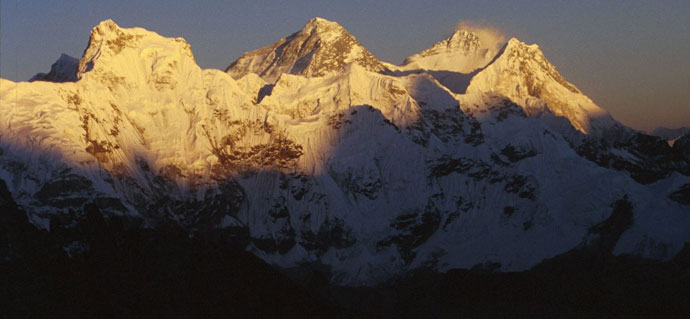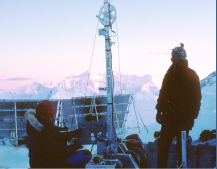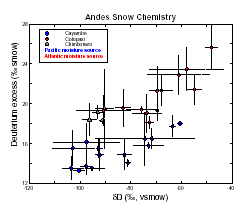High elevation ice cores record natural and
anthropogenic changes in the background atmosphere
The world's major mountain ranges represent a unique and sensitive component of the Earth system, and are likely to be among the first regions to respond to global climate change. Recent evidence indicates that alpine freezing level heights (the altitude of 0°C isotherm) are increasing, and the resulting widespread retreat of alpine glaciers and tropical ice cap margins is well documented. The International Geosphere-Biosphere Program recently launched a new initiative entitled 'Global Change and Mountain Regions' and made 2002 the International Year of Mountains. While the initiative encompasses several objectives, the primary effort focuses on developing a strategy for detecting signals of global environmental change in mountain environments.
Our research approach involves the collection and development of ice core glaciochemical records to investigate physical (temperature, atmospheric circulation, precipitation) and chemical change in mountain regions over timescales ranging from seasonal to glacial/interglacial. We are currently involved in a global array of ice core activities, and our work to date has resulted in several contributions to the understanding of high-elevation climate and environmental change.



Sulfate deposition at several sites in the Northern Hemisphere has been influenced by human activities. These results indicate that even the remote upper troposphere is impacted by fossil fuel use, which has implications for aerosol loading and ecosystem function. We are developing new techniques to investigate the transport and deposition of other pollutants (e.g., mercury, lead) to these regions.
Dust levels in the background atmosphere show a high degree of interannual variability, with long-range transport occurring on 103km scales. Detailed geochemical analysis of ice core particulate material indicates similar variability in dust source and source region conditions. When included in modeling studies, these data are critical for evaluating changes in atmospheric circulation, radiative forcing, and nutrient supply (e.g., iron) to terrestrial and ocean ecosystems.
High-resolution ice core data from mountain regions can be statistically compared with available meteorological data to produce calibrated paleoclimate proxy records. These records are being used to reconstruct several ocean/atmosphere phenomena prior to the instrumental period, including the Asian monsoon system, the El Niņo-Southern Oscillation, the Pacific Decadal Oscillation, and the North Atlantic/Arctic Oscillation.
Selected References
Kang, S., P.A. Mayewski, D. Qin, Y. Yan, S. Hou, D. Zhang, and K.J. Kreutz, Glaciochemical records from Mt. Everest ice core: relationship to atmospheric circulation over Asia, Atmospheric Environment, 36(21), 3351-3361, 2002.
Kreutz, K.J., and E.R. Sholkovitz, Major element, rare earth element, and sulfur isotopic composition of a high-elevation firn core: Sources and transport of mineral dust in Central Asia, Geochemistry, Geophysics, and Geosystems (G3), 1, 2000GC000082, 2000.
Mayewski, P.A., G. Holdsworth, M.J. Morrison, K.K. Ferland, and L.D. Meeker, Ice-core sulfate from three Northern Hemisphere sites: Source and temperature forcing implications, Atmospheric Environment, 27A, 2915-2919, 1993.

